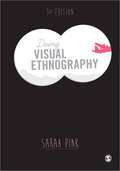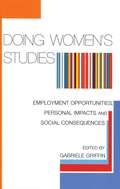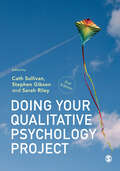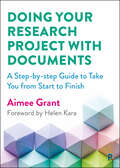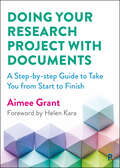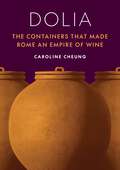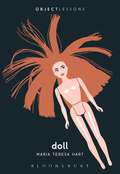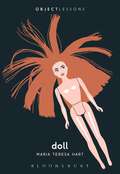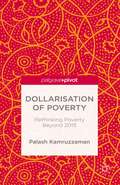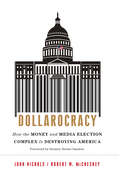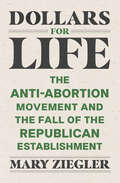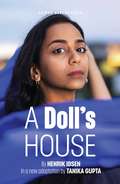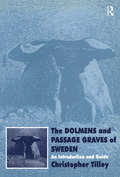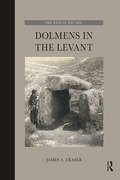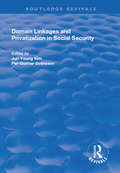- Table View
- List View
Doing Visual Ethnography (PDF)
by Sarah PinkEssential reading for anyone wishing to engage with images, technologies and society, Doing Visual Ethnography is a milestone in ethnographic and visual research. The third edition of this classic text includes new chapters on web-based practices for visual ethnography and the issues surrounding the representation, interpretation and authoring of knowledge with the rise of digital media. The book provides a foundation for thinking about visual ethnography and introduces the practical and theoretical issues relating to the visual and digital technologies used in the field. Drawing upon her original research and the experiences of other ethnographers, Sarah Pink once again challenges our understanding of the world and sets new agendas for visual ethnography by: Helpfully illustrating key concepts within real world contexts Introducing examples from both analogue and digital media Exploring material and electronic texts Setting out the shift towards applied, participatory and public visual scholarship. This book is a must-have for students and researchers across the social sciences who are interested in incorporating audiovisual media into their research practice.
Doing Women's Studies: Employment Opportunities, Personal Impacts and Social Consequences
by Gabriele GriffinWith the expansion of the EU in 2004 and its inclusion now of 25 European countries, the movement of workers across the Continent will affect the employment opportunities of women. But as this up-to-date investigation across nine countries shows, there remain significant differences amongst specific European countries regarding women's education and employment opportunities. Taking 1945 as its historical starting point, this sociological study, based on some 900 questionnaire responses and more than 300 in-depth interviews, explores the complex inter-relationship between women's employment, the institutionalization of equal opportunities, and Women's Studies training.This volume is the first to explore what happens to women who have undertaken Women's Studies training in the labour market. Factors influencing their actual employment experiences include employment opportunities for women in each country, their expectations of the labour market and gender norms informing those expectations, how far equal opportunities are actually enforced and the strength of local women's movements.Doing Women's Studies provides unique information about, and insightful analyses of, the changing patterns of women's employment in Europe; equal opportunities in a cross-European perspective; educational migration; gender, race, ethnicity and nationality; and the uneven prevalence and impact of Women's Studies on the lifestyles and everyday practices of those women who have experienced it. The contributors are prominent feminist researchers from nine European countries. Their findings will be of interest to sociologists and gender studies experts working in the areas of gender, employment, equal opportunities and the impact of education on employment.
Doing Women's Studies: Employment Opportunities, Personal Impacts and Social Consequences
by Gabriele GriffinWith the expansion of the EU in 2004 and its inclusion now of 25 European countries, the movement of workers across the Continent will affect the employment opportunities of women. But as this up-to-date investigation across nine countries shows, there remain significant differences amongst specific European countries regarding women's education and employment opportunities. Taking 1945 as its historical starting point, this sociological study, based on some 900 questionnaire responses and more than 300 in-depth interviews, explores the complex inter-relationship between women's employment, the institutionalization of equal opportunities, and Women's Studies training.This volume is the first to explore what happens to women who have undertaken Women's Studies training in the labour market. Factors influencing their actual employment experiences include employment opportunities for women in each country, their expectations of the labour market and gender norms informing those expectations, how far equal opportunities are actually enforced and the strength of local women's movements.Doing Women's Studies provides unique information about, and insightful analyses of, the changing patterns of women's employment in Europe; equal opportunities in a cross-European perspective; educational migration; gender, race, ethnicity and nationality; and the uneven prevalence and impact of Women's Studies on the lifestyles and everyday practices of those women who have experienced it. The contributors are prominent feminist researchers from nine European countries. Their findings will be of interest to sociologists and gender studies experts working in the areas of gender, employment, equal opportunities and the impact of education on employment.
Doing Your Qualitative Psychology Project
by Cath Sullivan Stephen Gibson Sarah RileyEmbarking on your own psychology research? This book equips you with the skills you need to complete a qualitative project confidently. The book takes you through the process of doing your project, showing how to plan and execute each stage. It helps you make good decisions about key steps such as choosing a research topic, designing your project, doing ethical research and writing up. This second edition: Offers a host of learning features including ‘in a nutshell’ summaries, further reading, activities and top tips to help you develop your understanding and skills. Devotes more space to the important topics of project planning and doing ethical research with a new chapter on each. Enables you to critically evaluate your work, helping you conduct high-quality research. Discusses student success stories and cautionary tales illustrating, from start to finish, how qualitative projects are done in the real world. This is the perfect guide for undergraduates doing a final project or dissertation, and postgraduates who are relatively new to qualitative research.
Doing Your Qualitative Psychology Project
by Cath Sullivan Stephen Gibson Sarah RileyEmbarking on your own psychology research? This book equips you with the skills you need to complete a qualitative project confidently. The book takes you through the process of doing your project, showing how to plan and execute each stage. It helps you make good decisions about key steps such as choosing a research topic, designing your project, doing ethical research and writing up. This second edition: Offers a host of learning features including ‘in a nutshell’ summaries, further reading, activities and top tips to help you develop your understanding and skills. Devotes more space to the important topics of project planning and doing ethical research with a new chapter on each. Enables you to critically evaluate your work, helping you conduct high-quality research. Discusses student success stories and cautionary tales illustrating, from start to finish, how qualitative projects are done in the real world. This is the perfect guide for undergraduates doing a final project or dissertation, and postgraduates who are relatively new to qualitative research.
Doing Your Qualitative Psychology Project
Embarking on your own psychology research? This book equips you with the skills you need to complete a qualitative project confidently. The book takes you through the process of doing your project, showing how to plan and execute each stage. It helps you make good decisions about key steps such as choosing a research topic, designing your project, doing ethical research and writing up. This second edition: Offers a host of learning features including ‘in a nutshell’ summaries, further reading, activities and top tips to help you develop your understanding and skills. Devotes more space to the important topics of project planning and doing ethical research with a new chapter on each. Enables you to critically evaluate your work, helping you conduct high-quality research. Discusses student success stories and cautionary tales illustrating, from start to finish, how qualitative projects are done in the real world. This is the perfect guide for undergraduates doing a final project or dissertation, and postgraduates who are relatively new to qualitative research.
Doing Your Research Project with Documents: A Step-by-Step Guide to Take You from Start to Finish
by Aimee GrantStudents and researchers have an abundance of materials and sources available to them via the internet for use in their projects. However, there is little practical guidance available on the fundamentals of performing qualitative research with documents. This valuable book enables readers to undertake high-quality, robust research using documents as data. Encouraging critical consideration of research design, the book guides readers step-by-step through the process of planning and undertaking a research project based on documentary analysis. It covers selecting a research topic and sample through to analysing and writing up the data. The book includes: • a wealth of case studies demonstrating how lessons can be applied in practice; • summary boxes and suggestions for further reading in each chapter to guide learning; • helpful online resources to facilitate designing your own research. Accessible and comprehensive, this book will be invaluable for both students and researchers alike who are new to documentary analysis. All the Resources included in this book are available to download on the book’s webpage at https://policy.bristoluniversitypress.co.uk/doing-your-research-project-with-documents/online-resources. Look for the Online Resources logo throughout the book.
Doing Your Research Project with Documents: A Step-by-Step Guide to Take You from Start to Finish
by Aimee GrantStudents and researchers have an abundance of materials and sources available to them via the internet for use in their projects. However, there is little practical guidance available on the fundamentals of performing qualitative research with documents. This valuable book enables readers to undertake high-quality, robust research using documents as data. Encouraging critical consideration of research design, the book guides readers step-by-step through the process of planning and undertaking a research project based on documentary analysis. It covers selecting a research topic and sample through to analysing and writing up the data. The book includes: • a wealth of case studies demonstrating how lessons can be applied in practice; • summary boxes and suggestions for further reading in each chapter to guide learning; • helpful online resources to facilitate designing your own research. Accessible and comprehensive, this book will be invaluable for both students and researchers alike who are new to documentary analysis. All the Resources included in this book are available to download on the book’s webpage at https://policy.bristoluniversitypress.co.uk/doing-your-research-project-with-documents/online-resources. Look for the Online Resources logo throughout the book.
Dokumentarische Gefüge: Relationalitäten und ihre Aushandlungen (Das Dokumentarische. Exzess und Entzug #8)
by Tabea Braun Felix Hüttemann Robin Schrade Leonie ZilchWie wird Wirklichkeit erfasst und Wissen organisiert? Im Rahmen von dokumentarischen Praktiken werden diese Frage und die damit verbundenen Machtdynamiken immer wieder ausgehandelt. Die Beiträger*innen bestimmen aus interdisziplinärer Perspektive dokumentarische Gefüge als temporäre, spontane und dynamische Relationalitäten, über die nicht-linear, nicht-hierarchisch und nicht-patriarchal nachgedacht wird. Damit verweisen sie auf Beziehungen, Situationen und (Problem-)Lagen des Dokumentarischen, die sich als Intensitäten von Lebensverhältnissen, Wissensorganisationen, Umgebungen oder Infrastrukturen verstehen lassen.
Dokumentwerden: Zeitlichkeit, Arbeit, Materialisierung (Das Dokumentarische. Exzess und Entzug #9)
by Tilman Richter Julia Schade Marion Biet Jana Hecktor Vanessa KlomfaßWie entsteht ein Dokument? Dokumente erlauben dokumentarische Praktiken und fordern diese sogar ein: Sie verlangen also einen spezifischen Umgang mit konkreten Materialitäten, der ihren Verweisungscharakter in Rechnung stellt. Umgekehrt sind es erst Praktiken des Zeigens, Bezeugens, Bewahrens oder Darstellens, die Dokumente kreieren und mediale Artefakte als Dokumentation kennzeichnen. Die Beiträger*innen nehmen genau dieses Dokumentwerden in den Fokus und werfen einen Blick auf die Prozesse, die dem Dokumentarischen zugrunde liegen - so z.B. Übersetzungen, Mobilisierungen und Einsätze.
Dolia: The Containers That Made Rome an Empire of Wine
by Caroline CheungThe story of the Roman Empire’s enormous wine industry told through the remarkable ceramic storage and shipping containers that made it possibleThe average resident of ancient Rome drank two-hundred-and-fifty liters of wine a year, almost a bottle a day, and the total annual volume of wine consumed in the imperial capital would have overflowed the Pantheon. But Rome was too densely developed and populated to produce its own food, let alone wine. How were the Romans able to get so much wine? The key was the dolium—the ancient world’s largest type of ceramic wine and food storage and shipping container, some of which could hold as much as two-thousand liters. In Dolia, classicist and archaeologist Caroline Cheung tells the story of these vessels—from their emergence and evolution to their major impact on trade and their eventual disappearance.Drawing on new archaeological discoveries and unpublished material, Dolia uncovers the industrial and technological developments, the wide variety of workers and skills, and the investments behind the Roman wine trade. As the trade expanded, potters developed new techniques to build large, standardized dolia for bulk fermentation, storage, and shipment. Dolia not only determined the quantity of wine produced but also influenced its quality, becoming the backbone of the trade. As dolia swept across the Mediterranean and brought wine from the far reaches of the empire to the capital’s doorstep, these vessels also drove economic growth—from rural vineyards and ceramic workshops to the wine shops of Rome.Placing these unique containers at the center of the story, Dolia is a groundbreaking account of the Roman Empire’s Mediterranean-wide wine industry.
Dolia: The Containers That Made Rome an Empire of Wine
by Caroline CheungThe story of the Roman Empire’s enormous wine industry told through the remarkable ceramic storage and shipping containers that made it possibleThe average resident of ancient Rome drank two-hundred-and-fifty liters of wine a year, almost a bottle a day, and the total annual volume of wine consumed in the imperial capital would have overflowed the Pantheon. But Rome was too densely developed and populated to produce its own food, let alone wine. How were the Romans able to get so much wine? The key was the dolium—the ancient world’s largest type of ceramic wine and food storage and shipping container, some of which could hold as much as two-thousand liters. In Dolia, classicist and archaeologist Caroline Cheung tells the story of these vessels—from their emergence and evolution to their major impact on trade and their eventual disappearance.Drawing on new archaeological discoveries and unpublished material, Dolia uncovers the industrial and technological developments, the wide variety of workers and skills, and the investments behind the Roman wine trade. As the trade expanded, potters developed new techniques to build large, standardized dolia for bulk fermentation, storage, and shipment. Dolia not only determined the quantity of wine produced but also influenced its quality, becoming the backbone of the trade. As dolia swept across the Mediterranean and brought wine from the far reaches of the empire to the capital’s doorstep, these vessels also drove economic growth—from rural vineyards and ceramic workshops to the wine shops of Rome.Placing these unique containers at the center of the story, Dolia is a groundbreaking account of the Roman Empire’s Mediterranean-wide wine industry.
Doll (Object Lessons)
by Maria Teresa HartObject Lessons is a series of short, beautifully designed books about the hidden lives of ordinary things.The haunted doll has long been a trope in horror movies, but like many fears, there is some truth at its heart. Dolls are possessed-by our aspirations. They're commonly used as a tool to teach mothering to young girls, but more often they are avatars of the idealized feminine self. (The word "doll" even acts as shorthand for a desirable woman.) They instruct girls what to strive for in society, reinforcing dominant patriarchal, heteronormative, white views around class, bodies, history, and celebrity, in insidious ways. Girls' dolls occupy the opposite space of boys' action figures, which represent masculinity, authority, warfare, and conflict. By analyzing dolls from 17th century Japanese Hinamatsuri festivals, to the '80s American Girl Dolls, and even to today's bitmoji, “Doll” reveals how the objects society encourages us to play with as girls shape the women we become.Object Lessons is published in partnership with an essay series in The Atlantic.
Doll (Object Lessons)
by Maria Teresa HartObject Lessons is a series of short, beautifully designed books about the hidden lives of ordinary things.The haunted doll has long been a trope in horror movies, but like many fears, there is some truth at its heart. Dolls are possessed-by our aspirations. They're commonly used as a tool to teach mothering to young girls, but more often they are avatars of the idealized feminine self. (The word "doll" even acts as shorthand for a desirable woman.) They instruct girls what to strive for in society, reinforcing dominant patriarchal, heteronormative, white views around class, bodies, history, and celebrity, in insidious ways. Girls' dolls occupy the opposite space of boys' action figures, which represent masculinity, authority, warfare, and conflict. By analyzing dolls from 17th century Japanese Hinamatsuri festivals, to the '80s American Girl Dolls, and even to today's bitmoji, “Doll” reveals how the objects society encourages us to play with as girls shape the women we become.Object Lessons is published in partnership with an essay series in The Atlantic.
Dollarisation of Poverty: Rethinking Poverty Beyond 2015
by Palash KamruzzamanThis book offers a critical analysis on employing a universal understanding of poverty and suggests ways forward for poverty reduction for developing countries in a post-2015 era. Taking specific country-contexts into account, the author argues that national poverty lines should be the benchmark for future anti-poverty policies.
Dollarocracy: How the Money and Media Election Complex is Destroying America
by John Nichols Robert W McChesneyFresh from the first 10 billion election campaign, two award-winning authors show how unbridled campaign spending defines our politics and, failing a dramatic intervention, signals the end of our democracy.Blending vivid reporting from the 2012 campaign trail and deep perspective from decades covering American and international media and politics, political journalist John Nichols and media critic Robert W. McChesney explain how US elections are becoming controlled, predictable enterprises that are managed by a new class of consultants who wield millions of dollars and define our politics as never before. As the money gets bigger-especially after the Citizens United ruling-and journalism, a core check and balance on the government, declines, American citizens are in danger of becoming less informed and more open to manipulation. With groundbreaking behind-the-scenes reporting and staggering new research on "the money power,” Dollarocracy shows that this new power does not just endanger electoral politics; it is a challenge to the DNA of American democracy itself.
Dollars for Life: The Anti-Abortion Movement and the Fall of the Republican Establishment
by Mary ZieglerA new understanding of the slow drift to extremes in American politics that shows how the antiabortion movement remade the Republican Party “A sober, knowledgeable scholarly analysis of a timely issue.”—Kirkus Reviews “As Mary Ziegler shows us in this incisive and important book, anti-abortion activists have shaped the GOP in ways that even they could not have anticipated. Everyone interested in the past and future of American politics should read this book.”—Laura Kalman, University of California, Santa Barbara The modern Republican Party is the party of conservative Christianity and big business—two things so closely identified with the contemporary GOP that we hardly notice the strangeness of the pairing. Legal historian Mary Ziegler traces how the anti-abortion movement helped to forge and later upend this alliance. Beginning with the Supreme Court’s landmark decision in Buckley v. Valeo, right‑to‑lifers fought to gain power in the GOP by changing how campaign spending—and the First Amendment—work. The anti-abortion movement helped to revolutionize the rules of money in U.S. politics and persuaded conservative voters to fixate on the federal courts. Ultimately, the campaign finance landscape that abortion foes created fueled the GOP’s embrace of populism and the rise of Donald Trump. Ziegler offers a surprising new view of the slow drift to extremes in American politics—and explains how it had everything to do with the strange intersection of right-to-life politics and campaign spending.
A Doll's House: 30 Books and Teaching Unit
by Henrik IbsenOne of the best-known, most frequently performed of modern plays, A Doll's House richly displays the genius with which Henrik Ibsen pioneered modern, realistic prose drama. In the central character of Nora, Ibsen epitomized the human struggle against the humiliating constraints of social conformity. Nora's ultimate rejection of a smothering marriage and life in "a doll's house" shocked theatergoers of the late 1800s and opened new horizons for playwrights and their audiences.But daring social themes are only one aspect of Ibsen's power as a dramatist. A Doll's House shows as well his gifts for creating realistic dialogue, a suspenseful flow of events and, above all, psychologically penetrating characterizations that make the struggles of his dramatic personages utterly convincing. Here is a deeply absorbing play as readable as it is eminently playable, reprinted from an authoritative translation.
A Doll's House: 30 Books And Teaching Unit: Dover Thrift Edition (Oberon Modern Plays)
by Henrik Ibsen Tanika GuptaNiru is a young Bengali woman married to an English colonial bureaucrat – Tom. Tom loves Niru, exoticising her as a frivolous plaything to be admired and kept; But Niru has a long-kept secret, and just as she thinks she is almost free of it, it threatens to bring her life crashing down around her. Tanika Gupta reimagines Ibsen’s classic play of gender politics through the lens of British colonialism, offering a bold, female perspective exploring themes of ownership and race.
The Dolmens and Passage Graves of Sweden: An Introduction and Guide (UCL Institute of Archaeology Publications)
by Christopher TilleyThis book is the first comprehensive introduction and guide to Sweden’s most spectacular Stone Age monuments: the dolmens and passage graves, which began to be constructed over 5000 years ago. The introduction provides a detailed social interpretation of these monuments outlining how and why they were built and the ways in which they related to economy and landscape, politics, ceremony, symbolism and belief. This is followed by a systematic regional guide to all the major monuments in Skåne, Halland, Västergotland, Öland and Bohuslän, illustrated by numerous photographs, plans and maps.
The Dolmens and Passage Graves of Sweden: An Introduction and Guide (UCL Institute of Archaeology Publications)
by Christopher TilleyThis book is the first comprehensive introduction and guide to Sweden’s most spectacular Stone Age monuments: the dolmens and passage graves, which began to be constructed over 5000 years ago. The introduction provides a detailed social interpretation of these monuments outlining how and why they were built and the ways in which they related to economy and landscape, politics, ceremony, symbolism and belief. This is followed by a systematic regional guide to all the major monuments in Skåne, Halland, Västergotland, Öland and Bohuslän, illustrated by numerous photographs, plans and maps.
Dolmens in the Levant (The Palestine Exploration Fund Annual)
by James A. FraserWhen Western explorers first encountered dolmens in the Levant, they thought they had discovered the origins of a megalithic phenomenon that spread as far as the Atlantic coast. Although European dolmens are now considered an unrelated tradition, many researchers continue to approach dolmens in the Levant as part of a trans-regional phenomenon that spanned the Taurus mountains to the Arabian peninsula. By tightly defining the term 'dolmen' itself, this book brings these mysterious monuments into sharper focus. Drawing on historical, archaeological and geological sources, it is shown that dolmens in the Levant mostly concentrate in the eastern escarpment of the Jordan Rift Valley, and in the Galilean hills. They cluster near proto-urban settlements of the Early Bronze I period (3700–3000 BCE) in particular geological zones suitable for the extraction of megalithic slabs. Rather than approaching dolmens as a regional phenomenon, this book considers dolmens as part of a local burial tradition whose tomb forms varied depending on geological constraints. Dolmens in the Levant is essential for anyone interested in the rise of civilisations in the ancient Middle East, and particularly those who have wondered at the origins of these enigmatic burial monuments that dominate the landscape.
Dolmens in the Levant (The Palestine Exploration Fund Annual)
by James A. FraserWhen Western explorers first encountered dolmens in the Levant, they thought they had discovered the origins of a megalithic phenomenon that spread as far as the Atlantic coast. Although European dolmens are now considered an unrelated tradition, many researchers continue to approach dolmens in the Levant as part of a trans-regional phenomenon that spanned the Taurus mountains to the Arabian peninsula. By tightly defining the term 'dolmen' itself, this book brings these mysterious monuments into sharper focus. Drawing on historical, archaeological and geological sources, it is shown that dolmens in the Levant mostly concentrate in the eastern escarpment of the Jordan Rift Valley, and in the Galilean hills. They cluster near proto-urban settlements of the Early Bronze I period (3700–3000 BCE) in particular geological zones suitable for the extraction of megalithic slabs. Rather than approaching dolmens as a regional phenomenon, this book considers dolmens as part of a local burial tradition whose tomb forms varied depending on geological constraints. Dolmens in the Levant is essential for anyone interested in the rise of civilisations in the ancient Middle East, and particularly those who have wondered at the origins of these enigmatic burial monuments that dominate the landscape.
Domain Linkages and Privatization in Social Security
by JUN-YOUNG KIM AND PER-GUNNAR SVENSSONThis title was first published in 2000: This volume is based on papers presented at the sixth International Research Seminar on "Issues in Social Security", held by FISS on 12-15 June 1999 in Sigtuna, Sweden. The book relates to the discussion about the merits of improving the incentive structure of social security programmes by privatization. The first part contains two important chapters - the first looks at the interaction between programmes and how they make one of them to serve the purposes of the other. This mechanism is termed "domain linkage". The second chapter deals with welfare state programmes that contain behavioural risks, like health insurance, sickness benefits, unemployment and disability insurance - where moral hazard is a potential problem. The second part of the book groups a number of international comparative studies. The first three deal with retirement issues, and the fourth looks at the development of poverty and income distribution.
Domain Linkages and Privatization in Social Security
by Jun-Young Kim Per-Gunnar SvenssonThis title was first published in 2000: This volume is based on papers presented at the sixth International Research Seminar on "Issues in Social Security", held by FISS on 12-15 June 1999 in Sigtuna, Sweden. The book relates to the discussion about the merits of improving the incentive structure of social security programmes by privatization. The first part contains two important chapters - the first looks at the interaction between programmes and how they make one of them to serve the purposes of the other. This mechanism is termed "domain linkage". The second chapter deals with welfare state programmes that contain behavioural risks, like health insurance, sickness benefits, unemployment and disability insurance - where moral hazard is a potential problem. The second part of the book groups a number of international comparative studies. The first three deal with retirement issues, and the fourth looks at the development of poverty and income distribution.
